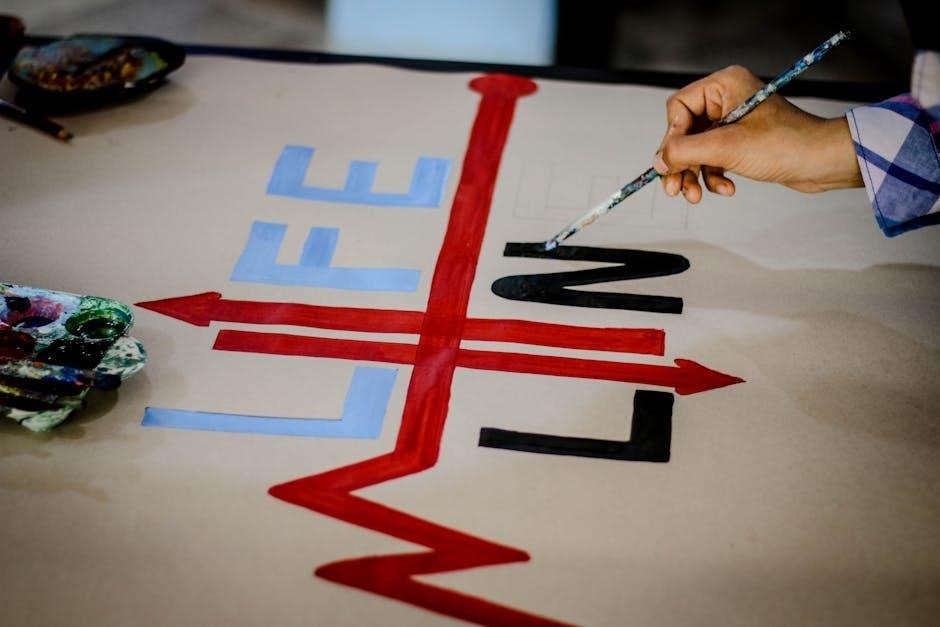The Line Bisection Test is a neuropsychological assessment tool used to detect spatial neglect by measuring a patient’s ability to identify the midpoint of a line.
It is a quick and effective method for evaluating unilateral spatial neglect, commonly observed in stroke survivors or those with brain injuries.
The test involves marking the center of horizontal lines, with deviations from the true midpoint indicating neglect.
Widely used in clinical and research settings, it provides insights into visuospatial perception and cognitive functioning.
Standardized and reliable, the Line Bisection Test is a key diagnostic tool for identifying and quantifying spatial neglect symptoms.
1.1 Definition and Purpose
The Line Bisection Test is a standardized neuropsychological assessment tool designed to evaluate visuospatial perception and detect unilateral spatial neglect.
Its primary purpose is to identify individuals who exhibit difficulty in perceiving and processing spatial information, often due to brain damage or stroke.
The test involves marking the midpoint of horizontal lines, with deviations from the true center indicating neglect.
It is widely used in clinical settings to diagnose spatial neglect and in research to study cognitive and motor disorders.
1;2 Historical Background and Development
The Line Bisection Test originated in neuropsychological research to assess spatial neglect, with early versions emerging in the mid-20th century.
Key developments included the introduction of standardized procedures in the 1980s and the creation of variations like the Character-Line Bisection Task (CLBT) in 2015.
Recent advancements have focused on digital automation, enhancing reliability and accessibility for clinical and research applications.
Test Administration and Scoring
The test involves marking the midpoint of horizontal lines on paper. Scoring measures deviation from the true center, with significant deviations indicating spatial neglect.
2.1 Standard Procedure for Line Bisection Testing
The test involves presenting a series of horizontal lines, typically 20 cm in length, on a sheet of paper. Patients are instructed to mark the perceived midpoint of each line with a pencil. The test is often conducted with both hands, starting with the right hand and then the left. The deviation from the true midpoint is measured to the nearest 0.5 mm, with the direction (left or right) recorded. This procedure is repeated for all lines, ensuring consistency and accuracy in assessing spatial perception and neglect symptoms. The task is simple, requiring minimal instruction, and is completed in a short time frame.
2.2 Scoring Methods and Interpretation of Results
The Line Bisection Test is scored by measuring the deviation of the mark from the true midpoint, recorded to the nearest 0.5 mm. A deviation exceeding 6 mm from the center indicates unilateral spatial neglect (USN). Results are quantified as the mean percent deviation, with left or right biases signaling hemispatial neglect. This method provides a clear, objective assessment of visuospatial perception, aiding in diagnosis and monitoring recovery progress in clinical settings.
Variations of the Line Bisection Test
Variations include the Character-Line Bisection Task (CLBT) and the Best-Hand Test. These modifications enhance diagnostic accuracy and adapt to different patient needs in clinical assessments.
3.1 The Character-Line Bisection Task (CLBT)
The Character-Line Bisection Task (CLBT) combines elements of line bisection and cancellation tasks, enhancing sensitivity in detecting visual neglect and right-left disorientation. This test involves marking the midpoint of lines with characters such as ‘d’ and ‘p’ on either side. Patients must identify the characters and bisect the lines, providing a dual assessment of spatial awareness and cognitive processing. The CLBT is particularly effective in identifying subtle neglect symptoms that traditional tests may miss, offering a more comprehensive evaluation of visuospatial deficits.
3.2 The Best-Hand Test (Bilateral Line-Bisection Test)
The Best-Hand Test, or Bilateral Line-Bisection Test, involves marking midpoints of lines with both hands. It assesses spatial neglect and inter-hemispheric differences. Each hand’s performance is compared, revealing asymmetries in visual processing. This test is useful for identifying neglect severity and hemispheric dominance. By evaluating both hands, it provides a nuanced understanding of spatial cognition, aiding in tailored rehabilitation strategies for stroke patients and those with brain injuries.

Clinical Applications
The Line Bisection Test is crucial for diagnosing unilateral spatial neglect, evaluating visual perception, and aiding in stroke rehabilitation. It is a quick, effective tool for clinicians.
4.1 Diagnosis of Unilateral Spatial Neglect (USN)
The Line Bisection Test is a primary tool for diagnosing unilateral spatial neglect (USN), a condition where individuals fail to perceive one side of their environment.
Patients with USN often mark the midpoint of lines significantly off-center, with deviations exceeding 6mm indicating neglect.
This test is particularly useful in stroke rehabilitation, as it helps identify visuospatial deficits and monitor recovery progress over time.
It is often combined with other assessments, such as the BIT, to ensure accurate diagnosis and comprehensive evaluation of neglect symptoms.
4.2 Use in Stroke Rehabilitation and Research
The Line Bisection Test plays a crucial role in stroke rehabilitation by assessing visuospatial deficits and monitoring recovery progress.
Research studies, such as one involving 170 PD patients, demonstrate its effectiveness in detecting leftward deviations in right hemisphere stroke patients.
It aids in designing targeted therapies to improve spatial awareness and functional abilities.
The test’s simplicity and reliability make it a valuable tool for both clinical practice and research, enhancing understanding of stroke-related cognitive and motor impairments;
Reliability and Validity
The Line Bisection Test demonstrates strong inter-rater and intra-rater reliability, ensuring consistent results across administrators and over time. Its validity as a measure of spatial neglect is well-established.
5.1 Intra-Rater and Inter-Rater Reliability
The Line Bisection Test exhibits high intra-rater and inter-rater reliability, ensuring consistent results when administered by the same or different evaluators. Studies show minimal variability in measurements across multiple sessions, demonstrating its robustness as a diagnostic tool. The test’s simplicity, involving clear instructions and objective scoring, contributes to its reliability. This consistency is crucial for accurately assessing spatial neglect and monitoring progress in clinical settings.
5.2 Cross-Cultural and Demographic Validity
The Line Bisection Test demonstrates strong cross-cultural and demographic validity, making it effective across diverse populations. Research indicates minimal bias related to age, gender, or cultural background, ensuring equitable assessment. The test’s reliance on visuospatial skills rather than language or education reduces confounding variables, enhancing its applicability globally. This broad validity supports its use in various clinical and research contexts, providing consistent and reliable results across different demographic groups.
Case Studies and Examples
A study involving 82 elderly stroke patients demonstrated impaired line bisection performance in 40 subjects, highlighting its diagnostic value in assessing spatial neglect post-stroke.
6.1 Line Bisection Performance in Healthy Controls vs. Individuals with Neglect
Healthy controls typically bisect lines accurately, marking the midpoint with minimal deviation. In contrast, individuals with unilateral spatial neglect often exhibit significant deviations, marking the line off-center toward the unaffected side. This discrepancy highlights the test’s sensitivity in detecting visuospatial deficits. The Line Bisection Test effectively distinguishes between neglect and normal performance, providing clear diagnostic insights into spatial awareness and cognitive processing impairments.
6.2 Real-World Applications in Cognitive and Motor Disorders
The Line Bisection Test is widely applied in assessing and monitoring recovery in stroke patients and those with cognitive or motor disorders. It helps identify visuospatial deficits and track progress during rehabilitation. The test is particularly useful in evaluating patients with Parkinson’s disease, brain injuries, and dementia, providing insights into their spatial awareness and neglect symptoms. Its practicality makes it a valuable tool in both clinical and research settings for improving patient outcomes and understanding cognitive rehabilitation processes.

Future Directions and Innovations
Digital versions enable remote testing, while automation enhances accuracy. Integration with other cognitive assessments provides a comprehensive evaluation of spatial neglect and related disorders.
7.1 Digital and Automated Versions of the Test
Digital and automated versions of the Line Bisection Test enhance precision and accessibility. Web-based platforms allow remote administration, reducing logistical challenges. Automated scoring ensures consistency and reduces human error. These innovations enable real-time data collection and analysis, facilitating larger-scale research. Digital tools also support longitudinal studies, tracking recovery progress in patients. Such advancements make the test more efficient and scalable for clinicians and researchers worldwide.
7.2 Integration with Other Cognitive Assessments
Integrating the Line Bisection Test with other cognitive assessments offers a comprehensive evaluation of spatial neglect and related cognitive deficits. Combining it with tasks like line crossing or cancellation tests provides a fuller understanding of visuospatial impairments. This multimodal approach enhances diagnostic accuracy and allows for the identification of subtle cognitive changes. Clinicians can tailor rehabilitation strategies by linking Line Bisection Test results with other neuropsychological measures, optimizing patient care and research outcomes.
The Line Bisection Test is a vital tool for detecting spatial neglect, offering quick and effective assessment of visuospatial function, particularly in stroke rehabilitation.
8.1 Summary of Key Findings
The Line Bisection Test (LBT) is a reliable and non-invasive tool for detecting unilateral spatial neglect (USN), commonly observed in stroke survivors.
Key findings highlight its effectiveness in assessing visuospatial perception and its widespread use in clinical and research settings.
The test demonstrates strong inter-rater and intra-rater reliability, making it a consistent measure for diagnosing neglect.
Additionally, variations like the Character-Line Bisection Task (CLBT) and digital adaptations expand its applicability.
Overall, the LBT remains a cornerstone in understanding and managing spatial neglect, providing valuable insights into cognitive recovery and rehabilitation.
8.2 Practical Implications for Clinicians and Researchers
The Line Bisection Test offers practical applications for clinicians in diagnosing and monitoring spatial neglect, particularly in stroke rehabilitation.
Its simplicity and reliability make it an invaluable tool for assessing visuospatial deficits and tracking recovery progress.
Researchers benefit from its standardized nature, enabling consistent data collection across studies.
Digital adaptations further enhance accessibility, allowing for remote assessments and larger-scale research participation.
Overall, the test bridges clinical and research needs, providing actionable insights for improving patient outcomes and advancing cognitive rehabilitation strategies;

References
- Kwon, S. (2020). Assessment and Intervention of Visual Perception and Cognition Following Brain Injury.
- Lee, B. H. (2004). Analyzing orientation, position, and movement in spatial neglect.
- Jee, H. J. (2015). The Character-line Bisection Task (CLBT) and its applications.
9.1 Key Research Papers and Citations
- Kwon, S. (2020) — Explores the Line Bisection Test’s role in assessing visual perception and cognition post-brain injury, emphasizing its diagnostic value in spatial neglect.
- Lee, B. H. (2004) ⏤ Discusses the test’s application in analyzing orientation and movement, highlighting its relevance in understanding visuospatial deficits.
- Jee, H. J. (2015) ⏤ Introduces the Character-Line Bisection Task, blending bisection and cancellation tasks for enhanced neglect assessment.

Further Reading
Explore detailed PDF guides on the Line Bisection Test for comprehensive understanding, including visual perception assessments and cognitive functioning evaluations.
10.1 Recommended Resources and PDF Guides
For in-depth understanding, download PDF guides on the Line Bisection Test, including research papers, clinical manuals, and case studies from reputable sources like PubMed and Google Scholar.
Explore resources on spatial neglect diagnosis, stroke rehabilitation, and cognitive assessments. Access digital versions of the Character-Line Bisection Task and Best-Hand Test for practical applications.
Refer to academic journals and clinical manuals for detailed methodologies, scoring systems, and interpretative guidelines to enhance your knowledge and application of the test.
